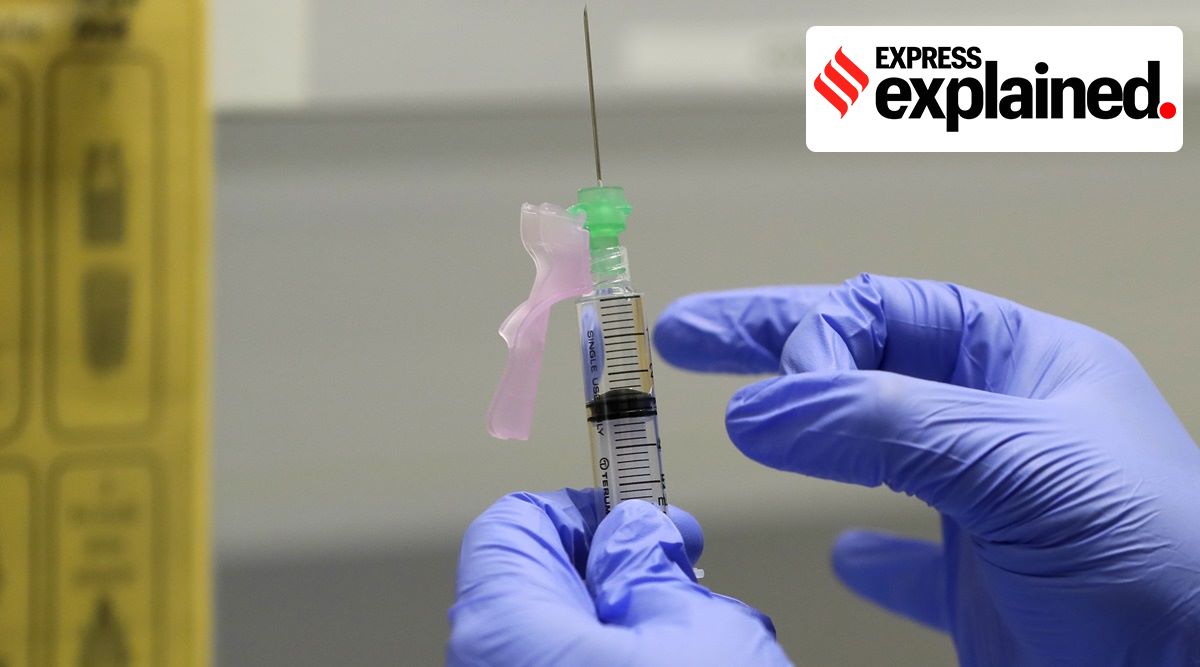
[ad_1]
 Out of the 187 Covid-19 vaccine candidates listed by the World Health Organization (WHO) as being under development, only five are specifically listed as exploring the intranasal route of delivery. (File)
Out of the 187 Covid-19 vaccine candidates listed by the World Health Organization (WHO) as being under development, only five are specifically listed as exploring the intranasal route of delivery. (File)
Bharat Biotech announced on Wednesday it would be manufacturing up to a billion doses of a single-dose intranasal vaccine. It is a key step towards the country getting its first vaccine administered through this route.
What is an intranasal vaccine?
Vaccines are delivered through different routes, with the most common being injectable shots delivered into the muscles (intramuscular) or the tissue just between the skin and the muscles (subcutaneous). Other routes of delivery, especially in some vaccines for infants, include administering the liquid solution orally instead of injecting. In the intranasal route, the vaccine is sprayed into the nostrils and inhaled.
What is the importance of such a vaccine for Covid-19?
The single-shot intranasal Covid-19 vaccine developed by the Washington University School of Medicine in St Louis and licensed to Bharat Biotech aims to overcome potential difficulties with mass vaccination and reduce the cost by doing away with the need for needles and syringes.
Intranasal vaccines are also expected to cut down on the dependence on various trained personnel to administer the vaccine, according to experts.
“Let’s not forget that, with the scale of the pandemic, just the logistics of actually shipping a vaccine, having it available and then having people trained to give an injection in the arm is not so easy. So, one attraction with the intra nasal vaccine is that it’s very simple to use — you just squirt it into your nose — and it’s something that can be self-administered in pandemics and outbreaks,” said Dr Davinder Gill, former CEO of Hilleman Laboratories.
📣 Express Explained is now on Telegram. Click here to join our channel (@ieexplained) and stay updated with the latest
“It’s an easy-to-deliver vaccine,” said vaccine scientist Dr Gagandeep Kang. “It’s going into a mucosal surface, likely to be restricted (and there is a) likelihood of lower safety events. It can be delivered in combination with influenza vaccines,” she said.
Virologist and Wellcome Trust DBT India Alliance CEO Dr Shahid Jameel said an an intranasal vaccine could also help in building a different kind of immune response.
“Both intranasal and intramuscular vaccines produce a response in the blood… But, vaccines administered through the nose or mouth would also tap into another set of immune cells found in mucosal tissues. The B cells that reside here can make another type of antibody, called IgA, that is very effective in destroying gut and airway pathogens. T cells in this tissue can create a memory and patrol the places they first encountered the pathogens,” he added.
Are there potential issues with a vaccine such as this?
Not many are considering the intranasal route for administering their Covid-19 vaccine. Out of the 187 Covid-19 vaccine candidates listed by the World Health Organization (WHO) as being under development, only five are specifically listed as exploring the intranasal route of delivery.
This is because there is very little evidence to back the effectiveness of this route of delivery so far and, save for some flu vaccines, attempts to deliver vaccines have not been successful, according to experts.
“Despite the theoretical advantages, the intranasal approach for vaccination is largely unproven. While this concept has been tested quite extensively in animals, whether this holds true in humans is still largely untested and so the clinical trials here will definitely have to be watched closely,” said Dr Gill. “Save for the flu vaccine, there really isn’t much of a precedent for using such a vaccine.”
“There was a trial of a measles flu vaccine which did not meet the non-inferiority criteria,” said Dr Kang. “The nasal flu vaccines which are live-attenuated vaccines have not done hugely well. We don’t know if it’s a problem with the fact that they are flu vaccines, or whether it is an issue with it being a nasal vaccine.” She said there is also uncertainty related to what dosage you give with a spray versus an injection.
Only very small volumes — typically around 0.1 ml — can be administered in each nostril through the intranasal route, Dr Jameel said. “The vaccine antigens should be produced in high concentration. Proper delivery vehicles for either single or multiple use have to be developed and these present the most significant challenge,” he said.
📣 The Indian Express is now on Telegram. Click here to join our channel (@indianexpress) and stay updated with the latest headlines
For all the latest Explained News, download Indian Express App.
[ad_2]
Source link